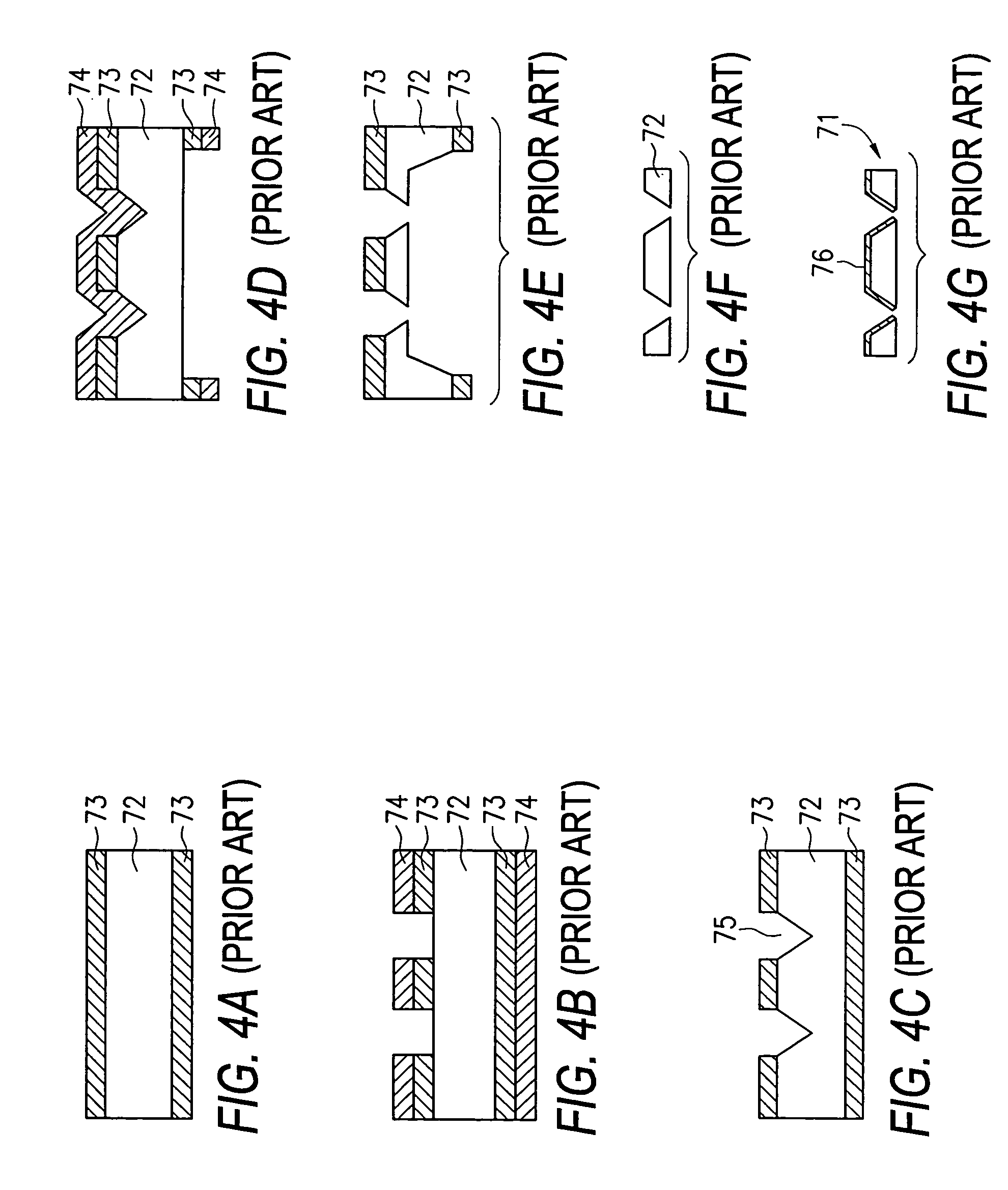Method of manufacturing a probe array
a technology of arrays and probes, applied in the field of optical pick-up sliders, can solve the problems of not disclosing the method of obtaining this aperture, not easy to form a very small aperture, and it is actually very difficult to stop etching just in time, so as to achieve high repeatability and high accuracy
- Summary
- Abstract
- Description
- Claims
- Application Information
AI Technical Summary
Benefits of technology
Problems solved by technology
Method used
Image
Examples
first embodiment
[0227]FIGS. 11A through 11F show a process of manufacturing an optical pickup-head slider (being simply referred to as a slider, hereinafter) in the present invention. As shown in FIG. 11A, a so-called SOI substrate obtained as a result of an SiO2 layer 3 having a thickness of approximately 1 μm and a single-crystal Si (silicon) layer 4 having a (100) plane on the top side thereof and having a thickness of approximately 10 μm being layered on a single-crystal Si substrate 2 having a thickness of hundreds of microns is used as a substrate 1. On the surface of the single-crystal Si layer 4, an SiO2 layer 5 having a thickness of hundreds of nanometers is layered. A portion of the SiO2 layer 5 at which an opening is to be made is removed by photolithographic etching as shown in FIG. 11A. This portion of the SiO2 layer 5 to be removed has a dimension determined such that an opening dimension of a bottom surface of a hole in an interface between the single-crystal Si layer 4 and SiO2 laye...
second embodiment
[0234]In the above-described embodiment, an SOI substrate is used as a substrate 1. A second embodiment in which a substrate other than an SOI substrate is used will now be described.
[0235]In the second embodiment, as shown in FIG. 13A, a substrate 21 is obtained as a result of an n-type Si layer 23 having a (100) plane on the top side thereof and having a thickness of tens of microns being layered on a p-type Si substrate 22 having a thickness of hundreds of microns, the substrate 21 having an SiO2 layer 24 having a thickness of hundreds of nanometers on the surface of the n-type Si layer 23. A portion of the SiO2 layer 24 at which an opening is formed is removed by photolithographic etching, as shown in FIG. 13A. A dimension of this portion of the SiO2 layer 24 to be removed is determined such that an aperture dimension of a bottom surface of a hole in an interface between the n-type Si layer 23 and p-type Si layer 22 will be in the range of tens of nanometers to hundreds of nanom...
third embodiment
[0239]A third embodiment in which a substrate obtained as a result of a low-concentration p-type or n-type Si layer being layered on a high-concentration p-type or n-type Si substrate is used will now be described making reference to a process chart shown in FIGS. 15A through 15E.
[0240]As shown in FIG. 15A, a substrate 31 is obtained as a result of a low-concentration p-type or n-type Si layer 33 having a (100) plane on the top side thereof and having a thickness of tens of microns being layered on a high-concentration p-type or n-type Si substrate 32 having a thickness of hundreds of microns, the substrate 31 having an SiO2 layer 34 having a thickness of hundreds of nanometers on the surface of the low-concentration Si layer 33. Here, it is important that respective impurity concentrations of the high-concentration Si substrate 32 and low-concentration Si layer 33 are high and low. Any combinations of p-type Si and n-type Si are possible, however, it is preferable that the low-conc...
PUM
| Property | Measurement | Unit |
|---|---|---|
| Thickness | aaaaa | aaaaa |
| Angle | aaaaa | aaaaa |
| Length | aaaaa | aaaaa |
Abstract
Description
Claims
Application Information
 Login to View More
Login to View More - R&D
- Intellectual Property
- Life Sciences
- Materials
- Tech Scout
- Unparalleled Data Quality
- Higher Quality Content
- 60% Fewer Hallucinations
Browse by: Latest US Patents, China's latest patents, Technical Efficacy Thesaurus, Application Domain, Technology Topic, Popular Technical Reports.
© 2025 PatSnap. All rights reserved.Legal|Privacy policy|Modern Slavery Act Transparency Statement|Sitemap|About US| Contact US: help@patsnap.com



